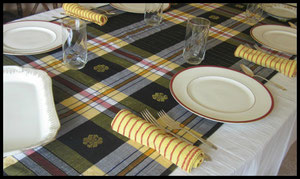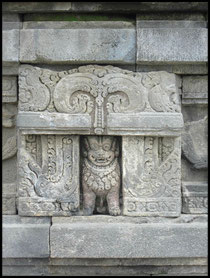Malaysia - Sarawak and Songket

Last year I posted about Malaysian songket - the luxurious, labor intensive, hand woven brocade cloth - and the Queen’s initiative to improve the lives of women and encourage training in the disappearing art of songket weaving through the organization Yayasan Tuanku Nur Zahirah. A second post on songket highlighted Habibah Zikri a designer and master of the craft who owns and runs Bibah Songket a family business.
So it’s GREAT to see the latest issue of Monocle Magazine featuring a regional profile dedicated to Sarawak, Malaysia. This nice cardstock pull-out is packed with facts and capsule sized stories categorized into sections including:
Nature and Wildlife:
By the numbers -- On the island of Borneo, Sarawak is home to “34 national parks, 6 wildlife sanctuaries and 8 nature reserves, with 185 species of mammals, 530 species of birds and 186 species of snakes…..”
Heritage and Culture: Sarawak is home to nearly 30 distinct indiginous groups!
Food and Drink: Including a mouth watering description of Sarawak Laksa – a delicious, spicy seafood and noodle stew. After looking around for a recipe to share, I settled on this one from Baby Sumo at the Eat Your Heart Out - Goodyfoodies Blog.
And also a lively section on Design and Craft including a profile of Tanoti House.

June Ngo, a textile educator and designer at the University of Sarawak is now co-managing this privatized spin off of the aforementioned Yayasan. Apparently Yayasan decided to focus on their operations in Terengganu and close this arm in Kuching. Ngo and partner Jacqueline Fong saved the business and continue to focus on the original mission: Provide training and support for women learning the weaving process and techniques, and protect the heritage craft by producing traditional and updated motifs and products with an eye toward both a regional and a global audience.
The Borneo Post wrote a two part article (part one) + (part two) with more background on the development of Tanoti House, and the rigorous training process and quality standards at Tanoti. At the time the article was written, local and international demand for their products well exceeded supply and they were looking to bring on more weavers. Have a look at this brief but impressive video of the production process at Tanoti House – it’s incredible!

There are a few songet table runners on the web site sourced from Terengganu and some unfinished cloth to be added to the textiles section soon. When you see the work that goes into creating a piece of songket fabric, you can understand why the cost is dear!
Given the array of craft and art and activities and adventures available -- including the annual Rainforest World Music Festival -- Sarawak is at the top of my travel list!
Adventurous Travel and the Parambanan Temple
The release of "Indonesia, Etc.: Exploring the Improbable Nation" by Elizabeth Pisani, called to mind an earlier work of some astoundingly adventurous travels through Indonesia that you may not yet have seen.
Highly recommended is “Ring of Fire” shown on PBS in the 1980’s. The film documents the ten-year voyage of the brothers Lorne and Lawrence Blair through the islands of Indonesia. It is an incredible adventure story as the brothers film and narrate their travels across the islands - searching out and spending time with many unique individuals and groups unknown to the rest of the world. For those interested: Amazon has the book (all 5 star reviews), Netflix has the movie, and you can find both at Lawrence Blair’s web site. You will be amazed. (If not, maybe you are not breathing)!

Some recent coverage of Elizabeth Pisani’s new book Indonesia, Etc. about her solo travels throughout Indonesia have piqued my interest, for sure. I’m next in line for it at our library and can’t wait to get my hands on the book. She visits places well off the beaten track (which means basically, anywhere other than Bali or Jakarta) taking advantage of any and all invitations, in a country she knows to be a warm and welcoming culture. The WSJ does a more comprehensive book review and The New York Times offers a short interview with the author, which you can read here. A photo of the Parambanan Temple accompany the NYT interview reinvigorated memories of my most recent trip to Java, so here are my photos and a little background on the Parambanan Temple complex:
At top is my own photo, on the beaten path, about 15 km northeast of Jogjakarta -- and well worth a visit.
“The tallest and the most beautiful Hindu temple in the world,” As noted in the pamphlet from the Temple Tourist Park. Subjectivity aside, it is the biggest Hindu complex on Java comprised of 224 temples. The three main buildings are dedicated to the three main Hindu divinities Shiva, Vishnu and Brahma – and three smaller temples to their corresponding animal identities - Bull, Eagle and Swan.

The main temples are considered outstanding examples of Hindu architecture with masterpieces of stone carvings found in relief illustrations of the Ramayana story. The temple complex plan, like Borobudur, is a Mandala - the symbol of Hindu cosmos.
The history of the temple, in brief: In the 8th century the Mataram kingdom was the largest in Java. It was ruled by a hindu nobleman name Sanjaya. In 750 AD he and his family were expelled by the Buddhist Syailendra Dynasty. One century later a decendent of King Sanjaya married into the Syailendra clan and reintroduced Hindu culture. He initiated the building of many temples. The Parambanan Temple complex constructed in 3 concentric squares is comprised of 224 temples in all. Built to commemorate the Sanjaya Dynasty’s return to power, the temple was ultimately left uncared for as the Mataram people left the area for East Java – UNESCO cites the possibility of a volcanic eruption from the nearby Mount Merapi . Later, an earthquake destroyed the temple in 16th century.
Proper restoration of the temple began in 1930 and continues to the present. In 2006 there was another earthquake which has damaged the temples significantly. So if you do visit, there is much to see that is amazing -- but also quite a lot of rubble and work in progress! Read more about it: Borobudur Park, and UNESCO

